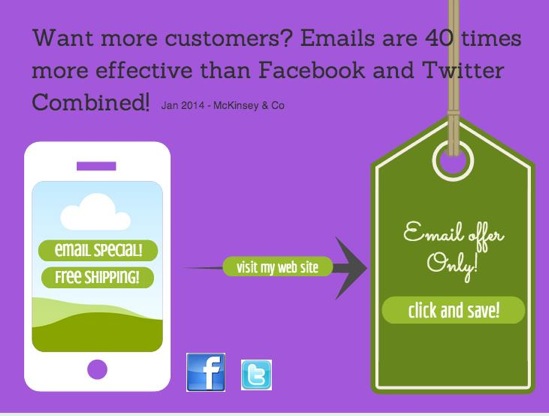by guest blogger Andy Derrick
These foundational building blocks help artists constructing an effective online presence and enhance sales opportunities.

This is the final article in a 3-part series. The first article explained the importance of having a high-quality digital portfolio and first steps to start building one. Article two was meant to simplify all the digital jargon that can be so confusing. It provided a basic understanding of digital images and how different file types should be used. Now, we get into the fun stuff: using your portfolio to build an online presence.
The internet gives you the opportunity to connect with a worldwide audience of art buyers. I’m going to jump into six strategies you can use to grow an online presence and reach your target audience. This is meant to help you get started. From there, you can experiment with new, creative ideas and continually improve your efforts.
1. Create an artist website
Many artists have a website, but I see very few websites that are optimized for making sales or growing an email list (which we’ll cover later in this article.)
You need to understand why your website exists. These “why’s” should inform how you design your website and how you write content. In short, everything on your site should exist for a reason.
The three most important reasons your artist website exists is to give people a chance to connect with who you are as an artist and person, sell your artwork, and grow your email list. Your website should be designed in a way that “funnels” visitors to do these things.
Keep your website simple. Think about your target audience for your website and before adding anything, ask whether it is necessary to accomplish the above goals.
Pro-tip: Research what other artists with similar artwork to your own are doing with their website (and make sure they’re experiencing some level of success with their site).
2. Make it easy to buy
Visitors are coming to your website to see your artwork. If you already have quality photos to represent your work, then you’re all set to start selling through your site. Ideally, you should set up a shopping cart on your site. I would recommend using something like Shopify or WooCommerce as your shopping cart.
You should have a “Portfolio” or “Shop” section on your website that allows visitors to view your work. Most artists understand this, but most don’t make it easy to buy a specific artwork from the images in their portfolio. Here’s the best way to make it easy: when a website visitor clicks on a specific artwork in your portfolio or shop, it should pop-up as a larger image and have a sidebar that a) has a description of the artwork, b) shows the price for original and print options, and c) has a button that allows them to add it to a shopping cart and finalize their purchase.
If a visitor loves a piece of art but can’t figure out how to actually buy it, then you’re adding too many steps and you’re losing sales.
If you don’t have a shopping cart, but are selling artworks on a third party art sales website, each of your images in your portfolio should link to where a visitor can buy that specific artwork. For example, if you’re selling a specific landscape painting on a third-party gallery platform, a visitor should be able to click somewhere on that photo on your website and be sent to the page where they can buy the artwork on that gallery site.

.
3. Grow your email list
An email list is one of the most powerful tools for furthering your relationship with your fans and making more sales. Every time someone visits your website, they should easily know how to subscribe to your email list.Think of it this way— a potential buyer connects with the artwork on your website. How often do they say, “I love your art” and then not actually pull the trigger and buy? How valuable would it be to keep them updated and give them further chances to connect with you and your work?
That is the power of an email list. Without it, you’re letting potential collectors of your work float off into empty space where you’ll likely never have another chance to connect with them.
People often don’t buy until months or years after first seeing an artist’s work. That relationship and trust is something to be developed over time. Artists who find ways to engage fans regularly over long periods of time have much more success than those who count on a one-and-done sale.
You need to have a subscription form on every single page of your website. This gives you the best possible chance of collecting email addresses and building your list.

Again, this is making it easy for visitors to take action. If they love your work and who you are, they’ll subscribe to hear from you further. This gives you the opportunity to update them on new artworks you’ve completed, let them know when you have gallery shows coming up, and increase the chance they decide to become a collector of your work.
Pro-tip: Consider using MailChimp to manage your email list and send your emails. MailChimp integrates easily with SumoMe, so anyone who signs up through a SumoMe subscription form will be added to your list on MailChimp (and they have a free plan).
4. Blog about your artwork
Selling art is all about giving people an opportunity to connect with your work and who you are as an artist. One of the most powerful ways to do this is to write blog posts or make videos about the artwork you’re creating.
Give people a sneak peek into how you create your work and why you create your work. Let them see your passion.
Blogging about your creative process and inspiration is a way to build trust with your potential collectors and a powerful way to help them connect with your work in a way that makes them more likely to purchase an artwork.
For more info on blogging for artists, check out this article on ArtsyShark.
![]()
.
5. Create a social media following
You’ve most likely already heard that social media platforms are a great way to build a following and promote your artwork. I’ve talked to artists on all ends of the spectrum when it comes to social media— some who feel frustrated and don’t know how to use social media and other artists who say they get most of their sales through social media connections.
You have to do it right and test out different strategies. Here are a few tips and ideas for how to use social media:
- Social media is about creating connections. You can’t just post an artwork for sale and expect anything to happen. You need to engage with others, start building relationships, promote other people’s work, etc. You don’t need to spend every waking moment on social media, but set aside a bit of time to engage with your followers and connections.
- Share your blog posts. Share them on your own pages and share them in artist groups on the different social media platforms.
- Test out a few different platforms and see where you get the most traction. For artists, I typically suggest trying out Facebook, Instagram, and Pinterest. Where you experience the most social media success is highly dependent on who you are as an artist and what type of work you create, so try out some different strategies and find out what works best for you.
- On Instagram, learn how to use hashtags to increase exposure and pull in more followers.
- Think of social media as one piece of your entire online presence. It’s an ecosystem. Use social media to drive traffic to your website and other places you’re selling online.
For more info on social media for artists, check out this article on ArtsyShark.
6. Sell on art sales websites
The number of websites where you can sell your work online continues to grow. Some sell originals, some sell prints, some sell a mix of the two. Do some research and find out which websites are best for the type of artwork you create and try it out.
The beauty of these websites is they attract art buyers all on their own without you having to do the work. Most of them manage payments, shipping, and all the administrative tasks. And most of them also don’t require upfront payment to post your works for sale, they simply take a cut of your sales.
There are so many platforms and strategies for connecting with potential fans online. The strategies listed above are hardly exhaustive. I suggest trying out a few, manageable strategies. Pay attention to what is working, what isn’t, and make adjustments from there.
It’s important to think of all your marketing efforts as an ecosystem that work together to connect with fans of your art and lead to purchases of your work. The only way to learn is to jump in and monitor the results.


Speak Your Mind